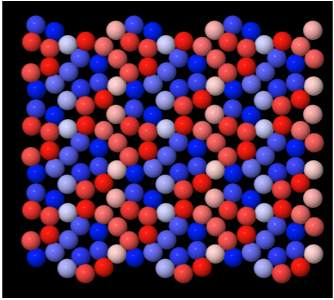AmericanChemicalSociety.com
Reports: AC5 48661-AC5: Adsorption of Hydrocarbons on Complex Metallic Alloy Surfaces - Lubricants and Superlubricity
Renee D. Diehl, Pennsylvania State University
The goal of this project is to increase our understanding of the interaction of hydrocarbons with aluminum-based alloys, including the complex metallic alloys that are very close in structure to quasicrystals. The motivation for these studies comes from the earlier observations for quasicrystalline surfaces that they have a low coefficient of friction, and might demonstrate superlubricity. Since quasicrystalline or quasicrystalline materials are being used as low-friction coatings in machines, it is important to understand how the interaction of typical lubricants (hydorcarbons) affects the frictional properties of the alloy surfaces. The methods to be employed are low-energy electron diffraction (LEED) and temperature-programmed desorption.
One set of experiments was carried out on the complex Al13Co4(100) surface, which approximates the structure and compositions of the 10-fold surface of the AlNiCo quasicrystal. Earlier computer simulation studies have suggested that there is no ordering for the short alkanes on this quasicrystal surface, an indication that the superlubricity may be preserved in the presence of at least some hydrocarbons.
Our LEED data for the Al13Co4(100) surface comprise more than 250 independent diffraction beams over an energy range extending from 50 eV to 500 eV, for a toal energy range exceeding 70,000 eV. This is more than an order of magnitude larger than any LEED study ever performed. The reasons for the large dataset are the complexity of this surface, its lack of symmetry, and the need for a large dataset for the large number of parameters to be fitted. Because we are greatly exceeding earlier limits of calculation size, this analysis has required many tests of the calculation to be sure that the calculation and the search algorithm are performing properly. An initial analysis has been completed, and the structure is found to be different from that deduced from an earlier scanning tunneling microscopy/density functional theory study. The difference is that the surface is much denser than previously thought, which makes sense logically (denser surfaces are more stable). New interpretations of the previous STM and DFT studies now concur with our finding.
We are now extending this analysis to study the effects of domain mixing and symmetry in the calculation. The surface consists of two types of domains and the LEED analysis must take both into account. This increases the symmetry of the diffraction pattern. However, there are several ways to deal with this type of symmetry mixing in the analysis, and we are testing the different methods. This part of the project is more for the purpose of extending the utility of LEED as a technique for studying complex structures. When this is complete, the entire structural study will be submitted to Physical Review B, and an additional paper related to the LEED technique will be published separately.
In the meantime, we have also studied the adsorption of Xe on this surface. We found that this surface is extremely sensitive to impurities, which was not the case in our earlier studies of related quasicrystal surfaces. Therefore, modifications were required in the experimental technique to be able to acquire data quickly before the surface was contaminated. We carried out adsorption isobars using LEED, and have also observed the diffraction from ordered Xe on this surface. Interestingly, the Xe appears to remain disordered until the 2nd layer adsorbs, when it forms a close-packed structure that is rotated at a non-symmetry angle with respect to the substrate. In time, this layer rotates to a direction in alignment with the crystal, apparently a result of the interaction of the electron beam with the surface, likely the cracking of residual gas molecules in the beam. We are in the process of analyzing that structure. We have also used the structure found in the LEED analysis discussed above to calculate a Xe-surface potential, and are also carrying out grand canonical Monte Carlo simulations of this growth. When this is complete, the entire study will be submitted to Physical Review B.
The next step is to extend the experiments and simulations to alkanes on this surface. Our preliminary measurements of methane and benzene on this surface did not result in any ordering. This agrees with the earlier simulations carried out by Curtarolo et al. on the growth of alkanes on a quasicrystal surface.
In parallel with these studies, we are studying the properties of adsorption and thermal desorption of rare gases and hydrocarbons from Al(111), to provide a comparison with a simpler system that has primarily (entirely, according to our LEED study) Al atoms at the surface.
The graduate student supported by this grant, Heekeun Shin, will complete his Ph.D. on the study of complex surfaces using LEED in December 2010. He has already accepted a position at Samsung in Seoul, South Korea, to start after his completion. The support from ACS-PRF was invaluable both in terms of funding his studies, but also in the sense that it has given him a broader view of the field of surface science. A second graduate student, Garry McGuirk, received summer support, and was trained in the experimental techniques. This project has provided extensive international interaction with collaborating scientists in Finland and France.
 Figure: Surface structure model of Al13Co4(100)
determined by LEED. The surface
layer is buckled and the red (blue) atoms are located above (below) the
plane. Unlike the bulk planes, the
surface layer is composed entirely of Al atoms.
Figure: Surface structure model of Al13Co4(100)
determined by LEED. The surface
layer is buckled and the red (blue) atoms are located above (below) the
plane. Unlike the bulk planes, the
surface layer is composed entirely of Al atoms.
Copyright © American Chemical Society

